
Driving a truck or bus in southern Africa is a dangerous occupation, and raising the standards of driver training is vital to reducing the high death toll from road traffic accidents.
UK overseas development charity Transaid is playing a major role in developing effective HGV and PSV driver training in Tanzania, Zambia and Uganda, and is now looking to roll the programme out to more countries including the Democratic Republic of Congo.
A delegation of UK partners and ambassadors, led by Transaid head of fundraising Florence Bearman and fundraising assistant Elena Leonard and hosted by Transaid's project manager in Zambia Victor Simfukwe, visited the Zambian Industrial Training Centre (ITC) to see for themselves what Transaid is achieving and what more the industry can do to make its work even more effective.
The ITC in the Zambian capital city Lusaka was formed in 1986 as a joint venture between the Zambian and German governments to raise the standards of vocational training in Zambia. Since then the Germans have shifted their focus to the copper mining industry in the north of the country and since 2004 Transaid has been the main overseas partner supporting the ITC, now part of the Zambian Ministry of Higher Education.
“The partnership with Transaid has seen massive benefits for us,” says Lloyd Mbasela, director of the ITC (pictured). “It has transformed the driver training we are able to deliver.”
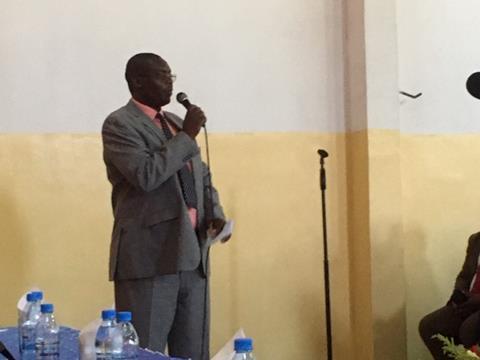
Only 10% of the ITC's funding comes from the government, with the rest coming from its commercial activities which see 2,000 to 4,000 trainees each year including HGV, PSV and fork-lift truck drivers receive high quality training. Its goal is grow the number of trainees by 400 each year but needs more vehicles and instructors to achieve this.
This training ranges from licence acquisition for novice drivers to defensive driving refresher training for experienced drivers and hazchem training for drivers of the numerous road tankers on Zambia's roads.
One of the senior driver trainers Albert Banda got involved with the ITC after his cousin was injured in a head-on collision between a Zambia to Malawi bus and a truck in which 34 people died. He also spent time as a truck driver and saw firsthand how long-distance drivers often do 19 hours behind the wheel a day to maximise earnings.
The number and quality of training vehicles based at the ITC have increased significantly since Transaid got involved, going from a single venerable Mercedes-Benz to a fleet that now includes 10 trucks, two buses and three fork-lift trucks.
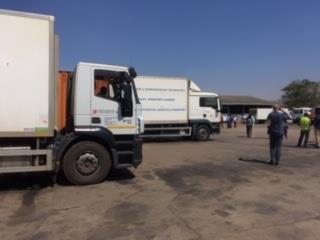
But ageing ERFs are still much in evidence and the centre faces a constant battle to keep these vehicles in a good state of repair. The ITC is not permitted to buy secondhand vehicles in Zambia and cannot afford new trucks so relies on vehicles donated by supporters overseas. But it still costs around £4,000 to export a truck from the UK.
Training a novice driver to test standard takes 15 days and costs 3,000 Zambian Kwacha (£180). A qualified HGV driver can earn around 2,000 Kwacha (£120) a month on local work and up to 5,000 Kwacha (£400) a month as an international driver, so gaining an HGV licence is a worthwhile investment.
“We have a lot of young people looking for work so there are plenty of people wanting to train as drivers,” says Mbasela. “Our challenge is finding enough people who can afford to pay.”
This is an especial problem in Zambia where there is a thriving black market in fake licences. The ITC also faces competition from private driver training schools in Zambia and other countries such as South Africa and so is striving to be seen as a centre of excellence that fleet operators want to use for training their drivers to be safe and legal on the roads.
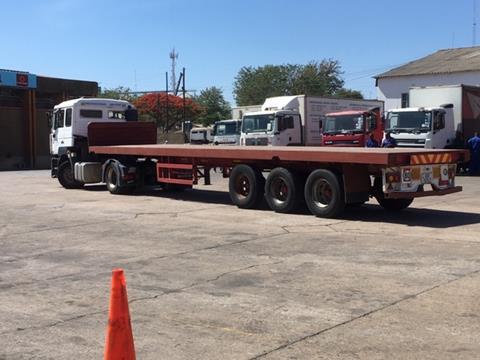
Transaid is clear that its role in the ITC is not to directly subsidise training courses but to support the centre with donated vehicles and seconded driver trainers to create a financially sustainable self-funding business.
Transaid's annual revenue of £1.7m (£700,000 of which is donated by the UK transport industry) is dwarfed by the £2bn raised by Save the Children for example but it works closely with other charities and governments to maximise its effectiveness.
Life on the road in Zambia
Zambia is landlocked and surrounded by eight other countries. It is a major transit route and many of the trucks on main north-south highway the Great North Road are from other African countries especially Tanzania and Namibia. As well as conventional 3+3 tractor-trailer combinations, roadtrains with a 3-axle tractor hauling two tandem axle trailers are common.
With little rail freight capacity, there are a lot of petroleum tankers on Zambian roads, which are often the target of fuel thieves. The pump price of diesel in Zambia is high at around £1 per litre (more than the price of a bottle of the finest local beer, Mosi) due to a combination of the weakness of the Zambia Kwacha against the dollar and 60% fuel duty. This drivers often supplement their wages by selling fuel siphoned from their truck tanks.
The high sulphur content of Zambian diesel means that Euro-6 trucks cannot be used; although low sulphur diesel is available it costs even more than the standard product.
While the vast majority of cars on the roads are Japanese - apart from the odd Ford Ranger pickup – there are few Japanese-built trucks other than a handful of Mitsubishi Fusos and Hinos. Most of the trucks on Zambian roads are imported secondhand from other righthand drive markets like the UK and increasingly Japan. German and Swedish brands still dominate though there are a fair few DAFs and the occasional Renault and IVECO. There are also a good number of US-spec bonneted tractors with the Freightliner an especially common sight.
Although many of the 3-series Scanias for example have clearly come from UK operators, 12% of Scania's 2018 sales were in Asia and this is a growing source of secondhand vehicles. A lot of Japanese trucks damaged in the 2011 tsunami made their way to Africa.
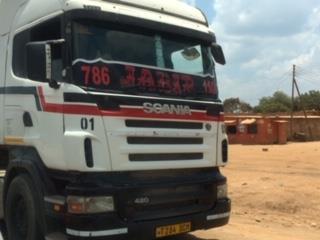
But many operators are now switching to new low-cost Chinese trucks, such as the Shacman F3000 which uses a Cummins engine and an MAN cab. These vehicles still have manual gearboxes, which is causing problems for the ITC as more and more of its donated training vehicles are now automatics. This is why the 2005 Volvo FM12 donated by Malcolm Group four years ago remains the ITC's most valuable truck – it was one of the last Volvos to come out of the factory with a manual 'box. Two of its sisters are still in use by Malcolm for short trips and shunting and chief executive Andrew Malcolm, who was on the visit, says one of these will soon be on its way to Zambia.
Because many Zambian drivers passed their tests in automatics they are struggling with the new wave of Chinese manual vehicles and are coming back to the ITC for refresher training.
There are no tachographs or drivers' hours rules so long driving stints on largely straight featureless roads makes long-distance truck driving a high-risk profession. There are no official statistics for the number of truck drivers and HGVs on the road or the rate of casualties among HGV drivers in Zambia, something the government is planning to address next year. But Mbasela says: “Traffic accident rates in Zambia are on the high side.”
•Tragically Victor Simfukwe was killed in a car crash on Christmas Day.
The incident happened in Mumbwa on the road to Mongu in Western Province, Zambia. A second person also died in the incident
Keeping it simple saves lives

The government of Zambia has set itself the goal of eradicating malaria by 2021 an ambitious target bearing in mind that in 2015 there were 5m cases of the mosquito-borne disease. If left untreated severe malaria can kill in a few hours, and children under five who have not acquired some level of immunity are at the highest risk.
Rural communities in remote areas, especially in the swampy regions of central Zambia, have to be very self-reliant as poor roads and large distances to health care facilities make it difficult to seek treatment quickly even when the signs of severe malaria are recognised. Efforts to eliminate the malaria-carrying mosquito and to vaccinate against the disease are being made but progress remains slow.
Miscarriages and still births are also common, with pregnant women having to walk up to 70kms in some cases to get medical help if they have complications with the birth.

The poor roads and cost of buying and maintaining motorised vehicles in these rural communities means a simple solution is needed – enter Transaid's bicycle ambulance. These robust machines are cheap to buy - £540 from a local Zambian supplier and Transaid partner – and easy to maintain as bicycles are the most common form of transport apart from walking. They are looked after and ridden by a network of emergency transport scheme (ETS) volunteers who give up their time to transport the sick to the nearest health care facility any time of the day or night.
Bicycle ambulances have been given to 85 rural communities in the northern districts of Serenje and Chitambo. Serenje has a population of 150,000 and is served by 29 community health care facilities and one hospital, while Chitambo has 14 health centres and one hospital serving a population of 63,000, so the biggest problem is getting the sick to where they can receive medical care rather than a lack of facilities. Since the arrival of the bicycle ambulances, the death rate from malaria in under-fives in Serenje has been cut from around six per year to zero and a significant number of mothers and babies are alive today as a result of them being transported quickly to the nearest health care facility.
The bicycle ambulances are part of a wider joint venture programme Mobilising Access to Maternal Health Services in Zambia (MAMaZ) Against Malaria which is also distributing mosquito nets (and encouraging villagers to use them for their intended purpose rather than for fishing or keeping insects off their crops) and educating people of the symptoms of severe malaria.
The programme involves training local volunteers to administer rectal artesunate suppositories (RAS) which stabilise victims of severe malaria for up to 12 hours, long enough to allow them to be transported by bicycle ambulance to a health care facility to receive a course of life-saving injections.
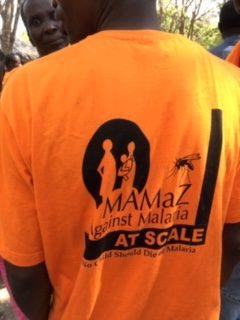
The Transaid delegation visited a community in Chitambo to see the MAMaZ volunteers in their bright orange tops in action, delivering their life-saving messages in plays and songs. Their importance was reinforced by the presence of Chief Chitambo himself, a highly influential hereditary tribal ruler who is part of the state government administration.
In the peak season for malaria between February and April, Chitambo alone can see up to 900 cases of malaria each week and while 90% of those are mild rather than the potentially fatal severe form this is among the highest incidence in the country. The arrival of the bicycle ambulances has been a contributory factor in Chitambo not seeing a single death from malaria in the 2019 peak season.
The success of the programme means that it is being rolled out to three more districts and RAS now forms part of the Zambian government's national malaria eradication programme.
With a little help from our friends

Transaid enjoys the support of 36 partners in the UK and the delegation to Zambia was made up of representatives of the partners and ambassadors:
Shane Brennan, chief executive, Cold Chain Federation
Richard Burnett, chief executive, RHA
Ben Colson, retired bus operator
Martin Dean, MD bus development, Go-Ahead Group and president, Confederation of Passenger Transport
Kelly Hobson, group senior marketing manager, Ligentia
Andrew Malcolm, chief executive, Malcolm Group
Tim Moran, MD, Lineage and president, Cold Chain Federation
Roger Turnbull, sales director, MAN Truck & Bus UK
To get involved contact Florence Bearman on florence@transaid.org
London bus arrives in Lusaka
The visit from the Transaid delegation to the ITC was an opportunity to hand over the latest addition to the training fleet – a 2006 Ale

xander Dennis single-deck bus donated by Go-Ahead Group. The red bus was based in Putney in south London and spent its first life carrying passengers along the south bank of the River Thames.
The official hand over took place in front of the Jayne Gray Assembly Hall, dedicated to the memory of the Scottish haulier who was tragically killed in a road traffic accident on a Transaid fund raising cycle ride in Zambia in 2018. The building was officially opened a few weeks earlier by a delegation of Transaid trustees led by chair Jo Godsmark.
An additional fork lift truck donated by UniCarriers was on its way to the ITC but had been delayed at Dar es Salaam.














